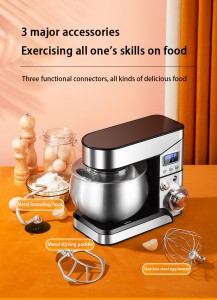When it comes to baking and cooking, having a multifunctional kitchen appliance can simplify your tasks and enhance your overall culinary experience. Two appliances that are commonly found in kitchens are stand mixers and food processors. While both have their own unique features, many wonder if they can use these devices interchangeably. In this blog post, we’ll take a deep dive into the differences and similarities between a stand mixer and a food processor, and find out if you can use a food processor as a stand mixer.
Learn about stand mixers:
A stand mixer is a powerful, multi-purpose appliance primarily used for mixing, stirring, and kneading dough. It comes with various attachments such as dough hook, whisk and wire beater. Stand mixers are often chosen for their high power output and slow mixing speed, making them ideal for bread making, cake batter preparation, whipping cream, and meringue. Their solid construction and stability allow them to handle heavy mixing tasks with ease.
Explore food processors:
Food processors, on the other hand, are designed to perform a range of tasks, including chopping, mincing, slicing, grating, and mashing. It operates at high speed for fast and efficient food processing. Food processors are often equipped with different blades and discs that can be interchanged for different textures and cuts. Its versatility in chopping vegetables, pureeing and mixing ingredients makes it a versatile kitchen companion.
The difference between a stand mixer and a food processor:
While there may be some similarities between a stand mixer and a food processor, they are designed for different purposes. The main differences lie in their design, functionality, and overall structure. Stand mixers focus on mixing and kneading tasks, while food processors excel at chopping, grinding, and blending ingredients.
Can a food processor replace a stand mixer?
Although food processors and stand mixers have some overlapping functions, using a food processor as a stand mixer replacement is not recommended. Specific attachments and slow mixing speeds for stand mixers facilitate a more controlled and precise mixing process, resulting in well-blended ingredients and the desired texture. Also, the bowl design of a stand mixer allows for better aeration and development of gluten in dough recipes, which can be a challenge with food processors.
In conclusion, while food processors and stand mixers share some similarities, they are fundamentally different devices with different purposes. While a food processor can effectively handle chopping, mashing, and grinding tasks, it’s not designed to replace a stand mixer’s ability to blend, knead, and blend ingredients. So, if you like to experiment with different culinary tasks, it is highly recommended to have both of these appliances in your kitchen. By investing in a food processor and stand mixer, you have the ultimate culinary toolkit to unleash your creativity in the kitchen.
Post time: Aug-11-2023

